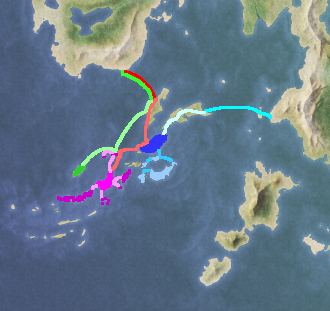The Migratory Age3300 BCE - 3100 BCEDuring this time, primitive people from the continents of Illidia and Medditerranea slowly made their way to the Kaevi Archipelago.
After first landing on islands north of Kaevi now belonging to Antanares, they quickly spread southward to eventually populate most of modern-day Kaevi.

The line shown is red shows the path of the Pokotil people. They encountered the Astokas on Mesonewa island, but were driven elsewhere.
The blue line represents the path of the Astokas, a warlike and relatively technologically advanced people.
They are believed to be the first people believed to make their way to the archipelago and are still remin ethnically distinct.
Colored in green is the path of the Tir tribe, a breakaway group of the Pokotil that were only able to settle on Novefronkaim.
The Brown Age3100 BCE - 2300 BCEDuring the Brown Age, the respective tribes developed more centralized governments and developed small economies.
The Pokotil and Til developed agrarian economies, tapping into the deep jungle reservoirs of food. The Pokotil in particular grew
to great numbers and developed a complex social structure. On the other hand, the Astokas developed an interest in the trade of
crafted items such as fine pottery, jewelry, and cut stone. They built the first paved roads in Kaevi and were the epicenter of the
birth of Zhondrasanism.

Most of the chiefdoms were controlled by large, dynastic families that varied in power. The power over the Astokas often drifted between the
Dukroil and Deisjei clans who wielded absolute power over their lands. Their leaders were treated as deities by the people and were known
to administer terrible punishments without second thought. Infighting between the Dukroil-Deisjei family led to the creation of the
Harmahalta dynasty. This group controlled most of Mesonewa and the northern half of Lailpon, but behaved much more cruelly to their people.
The Pokotil were led by the Fintasei family, a very large family that, compared to their neighbors to the north, gave their subjects a high
degree of personal freedom. The Tir had no single leader, but did have local elder council who frequently collaborated with other villages.


 Re: Kaevise History
Re: Kaevise History
